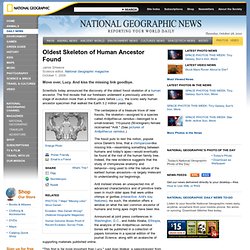

DNA Evidence. Oldest Skeleton of Human Ancestor. October 1, 2009 Move over, Lucy.

And kiss the missing link goodbye. Scientists today announced the discovery of the oldest fossil skeleton of a human ancestor. The find reveals that our forebears underwent a previously unknown stage of evolution more than a million years before Lucy, the iconic early human ancestor specimen that walked the Earth 3.2 million years ago. The centerpiece of a treasure trove of new fossils, the skeleton—assigned to a species called Ardipithecus ramidus—belonged to a small-brained, 110-pound (50-kilogram) female nicknamed "Ardi. " The fossil puts to rest the notion, popular since Darwin's time, that a chimpanzee-like missing link—resembling something between humans and today's apes—would eventually be found at the root of the human family tree.
Ardi instead shows an unexpected mix of advanced characteristics and of primitive traits seen in much older apes that were unlike chimps or gorillas (interactive: Ardi's key features). Ardi Surrounded by Family. Human Origins Project. About the Project The Human Origins Project, a joint initiative of the National Geographic Society and the Turkana Basin Institute, will utilize cutting-edge technology to become the largest and most informative multilingual resource available on the subject of human evolution.

Over the past 35 years, the Koobi Fora region in northern Kenya’s Turkana Basin has yielded a wealth of fossil material that has revealed a great deal of information about human history and origins. Some 16,000 fossils, including 350 hominid specimens, have been collected from the basin. The findings help scientists understand hominid behavior like tool use, piece together basic hominid lineages, and understand hominid diversity. Based on past successes in the Turkana Basin, researchers are hopeful that the next five to ten years of fieldwork will yield important new finds. Project Goals. Climate Change. February 2, 2006 It may be a threat to humans' long-term future on the planet, but climate change may have helped bring us into being in the first place, some scientists say.
Some human-origins theories suggest that ancient climate changes acted as powerful evolutionary drivers, spurring our ancestors to stand tall on two legs, grow large brains, and develop other human traits (related reading: "Was Darwin Wrong? "). The evolution of early human species, so the theories go, was concentrated in periods marked by fluctuating environmental conditions. Other theories suggest that humankind emerged independently of climatic swings, with adaptations arising, for example, out of competition between or within species. While more evidence is needed to settle the debate, experts say the answer may lie at the bottoms of ancient African lakes. Records of ancient global climate change come mainly from ocean sediments. Early Human Fossils.
Human Genome. March 8, 2006 Signs of recent evolution by natural selection are widespread across the human genome, experts say.

Genome researchers at the University of Chicago have identified more than 700 regions in human DNA where apparently strong selection has occurred, driving the spread of genes linked to a broad range of characteristics. "These are very recent events—within the past ten thousand years," said Jonathan Pritchard, a geneticist whose laboratory team conducted the study. The results suggest that humans in different regions have continued to adapt in numerous ways to both environmental changes and cultural innovations. Many of the genetic changes Pritchard's group detected came during or after the emergence of agriculture, beginning about 10,000 years ago, and long after the formation of modern human populations. Some of the genes most strongly affected by selection were those associated with skin color, bone structure, and the metabolism of different foods. Changing World, Changing Genes. Human Evolution.